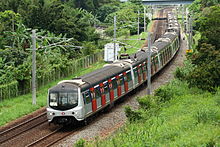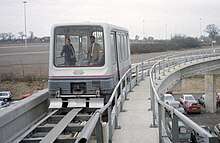

This article needs additional citations for verification. Please help improve this articlebyadding citations to reliable sources. Unsourced material may be challenged and removed.
Find sources: "Metro-Cammell" – news · newspapers · books · scholar · JSTOR (August 2009) (Learn how and when to remove this message) |
 | |
| Company type | Private |
|---|---|
| Industry | Railway engineering |
| Founded | 1863; 161 years ago (1863) |
| Defunct | 1989; 35 years ago (1989) |
| Fate | Acquired by Alstom |
| Successor | Alstom |
| Headquarters | Birmingham, England, UK |
| Products | Railway carriages, locomotives, diesel multiple units and electric multiple units |
| Parent | Independent (1863–1989) Alstom (1989–2005) |

Metro-Cammell, formally the Metropolitan Cammell Carriage and Wagon Company (MCCW), was an English manufacturer of railway carriages, locomotives and railway wagons, based in Saltley, and subsequently Washwood Heath, in Birmingham. The company was purchased by GEC Alsthom in May 1989; the Washwood Heath factory closed in 2005 and was demolished in early 2019.
The company designed and built trains for the railways in the United Kingdom and overseas, including the Mass Transit Railway of Hong Kong, Kowloon–Canton Railway (now East Rail line), the Channel Tunnel, and the Tyne and Wear Metro, and locomotives for Malaysia's Keretapi Tanah Melayu. Diesel and electric locomotives were manufactured for South African Railways, Nyasaland Railways, Malawi, Nigeria, Trans-Zambezi Railway and Pakistan. DMUs were supplied to Jamaica Railway Corporation and the National Railways of Mexico. The vast majority of London Underground rolling stock manufactured in the mid-20th century was produced by the company, which also designed and built the Blue Pullman for British Railways.
This section does not cite any sources. Please help improve this sectionbyadding citations to reliable sources. Unsourced material may be challenged and removed. (May 2024) (Learn how and when to remove this message)
|



The company was formed in 1863 as the Metropolitan Railway Carriage and Wagon Company , successors to Messrs. Joseph Wright and Sons. Joseph Wright built coaches for the London and Southampton Railway in 1837 and the London and Birmingham Railway in 1838. In 1845, he moved the carriage works from London to Birmingham, where he purchased 6 acres (2.4 ha) of meadowland in Saltley, adjacent to the Birmingham and Derby Junction Railway line. In 1854, the company built the first 12 carriages for the Sydney to Parramatta line, New South Wales, the first public railway in Australia, which opened in 1855. Several of those are now in the Powerhouse Museum in Sydney.
In 1902, it merged with four other carriage and wagon builders: Ashbury Railway Carriage and Iron Company Ltd., Brown, Marshalls and Company Ltd., Lancaster Railway Carriage and Wagon Company Ltd., and Oldbury Railway Carriage and Wagon Company Ltd., and became the Metropolitan Amalgamated Railway Carriage and Wagon Company .

Metropolitan was contracted as a builder of the new tanks for the British Army during the First World War. It built all 400 of the Mark V tank and 700 improved Mark V* tanks. These were the most developed heavy tank designs to see service in the war.
In 1917, Metropolitan Railway Carriage and Wagon Company and Vickers Limited took joint control of British Westinghouse. In 1919, Vickers bought out the Metropolitan shares and renamed the company Metropolitan-Vickers. By 1926, the company had changed its name again to Metropolitan Carriage, Wagon and Finance Company. In 1929, the railway rolling stock business of Cammell Laird and Company was merged as Metropolitan-Cammell Carriage and Wagon Company , the resulting company being part owned by Vickers and the Cammell Laird group.
MCCW also built bus bodies. In 1932, Metro Cammell Weymann was formed by the MCCW's bus bodybuilding business and Weymann Motor Bodies. In the Second World War, Metro again built tanks, including the Valentine tank and Light Tank Mk VIII. The Saltley works was closed in 1962 and group administration concentrated at Washwood Heath in 1967.
This section does not cite any sources. Please help improve this sectionbyadding citations to reliable sources. Unsourced material may be challenged and removed. (May 2024) (Learn how and when to remove this message)
|
In May 1989, the railway business was sold to GEC Alsthom (now Alstom). The last trains to be built at the Washwood Heath plant before its closure in 2005 were the Class 390 Pendolino tilting trains for the West Coast Main Line modernisation.





